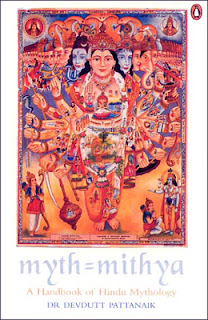Myth = Mithya A Handbook of Hindu Mythology
Note: since I first wrote this and other reviews of Devdutt Pattanaik's books, I have gained a better understanding of Hindu texts and scriptures. I believe Devdutt Pattanaik's writings are influenced heavily by western frameworks and agendas on the one hand, and introduce subtle and sometimes outright distortions in the interpretation of these texts. A small sample of the kinds of outright errors and distortions that would shame any scholar of Hinduism can be found in this blog post.I therefore do not recommend any of Devdutt Pattanaik's books that I have reviewed on my blog. - Abhinav, Nov 3, 2017.
Based on my reading of the author's two books, Jaya
Firstly, the style of writing is very crisp. To the point, almost. For example, in Jaya
Selections from the book:
Narayana's slumber represents a state when the consciousness is totally unresponsive to the world around. So deep is the slumber that Narayana is not even aware of himself. This is pralaya, dissolution, the period before the split between the Purusha and Prakriti. There is neither observer nor observation. Things have no form or name. Space collapses. Life entropies into a formless, nameless mass - the ocean of milk. Time is no longer sequential. The past, present, and future telescope into each other. The serpent of time coils rather than slithers. [pgs 40, 41]
Curses and boons are narrative tools to explain the concept of karma. A curse is a manifestation of debt. [page 57]
An overview of Hindu narratives shows an obsession with curses and boons. They are used to explain situations. They take the narrative forward. Curses and boons are essentially narrative tools to explain the idea of karma. Nothing in the Hindu world happens spontaneously. [page 59]
Hindu funeral rites involve the use of both fire and water. The body is cremated and the bones and ashes cast into the river. Fire represents the fire of moksha or release. The river represents samsara, the realm of rebirths. The two possible destinations of the soul are thus symbolically acknowledged. [pgs 54, 55]
The story of the Kauravas in Swarga informs us that there is always hope in the Hindu world, even for the worst of villains.
...
But there is one place where there is no hope. That place is called Put. It is reserved for Pitr who are trapped in the land of the dead with no hope of being reborn.
...
That is why a son and daughter are known as put-ra and put-ri i nSanskrit, meaning "deliverers from Put". By producing a child, a living person not only repays his debt to his ancestors he also helps a Pitr escape from the land of the dead into the land of the living. [page 75]
The disrobing of Draupadi is a visual representation of the collapse of order. The rise of the law of the jungle. Draupadi responds as Kali, refusing to tier her hair until she washes it in the blood of the Kauravas. [page 128]
Shiva communicates the truth of life through dance. Dance is the symbol if life. It is impermanent, lasting as long a the dancer dances. It flows through space and time, unfettered by any dimension or monebt. The wheel around the dancing Shiva is the merry-go-round of worldly events. The ego is swept away by the wheel. Shiva crushes the ego and dances on its back, offering an alternative. He balances himself on on his right foot, indicative of the still Purusha, and swings on his left leg, indicative of the ever-changing Prakriti. His right hand comforts his devotees while his left hand points to the interaction of the left and right feet. The fire he holds in one hand is tapa, ignited by refusing to submit to worldly stimuli. The rattle-drum in the other hand is created with the downward pointing triangle of matter separated from the upward-pointing triangle of the spirit. [page 162]
© 2010, Abhinav Agarwal. All rights reserved.
